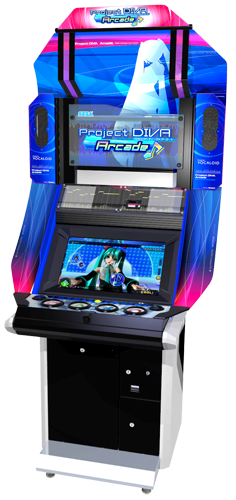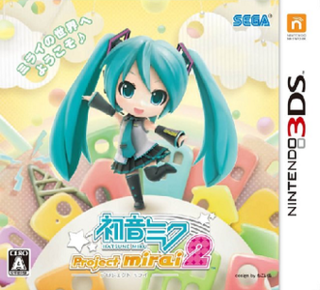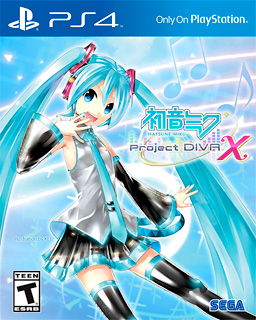
Vocaloid is a singing voice synthesizer software product. Its signal processing part was developed through a joint research project between Yamaha Corporation and the Music Technology Group in Universitat Pompeu Fabra, Barcelona. The software was ultimately developed into the commercial product "Vocaloid" that was released in 2004.

Hatsune Miku, officially code-named CV01, is a Vocaloid software voicebank developed by Crypton Future Media and its official mascot character, a 16-year-old girl with long, turquoise twintails. Miku's personification has been marketed as a virtual idol, and has performed at live virtual concerts onstage as an animated holographic projection.

Hatsune Miku: Project DIVA is a series of rhythm games created by Sega and Crypton Future Media. The series currently consists of 6 main titles, released on various PlayStation consoles, the Nintendo Switch, Microsoft Windows, and in arcades, the 2 Project Mirai games for the Nintendo 3DS, and 4 spin-offs for mobile and VR platforms. The series primarily makes use of Vocaloids, a series of singing synthesizer software developed by the Yamaha Corporation, and the songs created using these Vocaloids, most notably the virtual-diva Vocaloid Hatsune Miku.

Kaito is a Voice Synth developed by Yamaha Corporation for the Vocaloid engine, and distributed by Crypton Future Media. He has performed at live concerts onstage as an animated projection along with Crypton's other Voice Synth characters. His original codename was "TARO" back during "Project Daisy", the predecessor of Vocaloid, and was one of the original four known vocals for the project. His voice provider is Japanese singer Naoto Fūga. He was the fifth and final vocal released for the original Vocaloid software, and the second vocal released in Japanese.
Crypton Future Media, Inc., or simply Crypton, is a Japanese media company based in Sapporo, Japan. It develops, imports, and sells products for music, such as sound generator software, sampling CDs and DVDs, and FX and BGM libraries. The company also provides services of online shopping, online community, and mobile content.

Hatsune Miku: Project DIVA Arcade is a 2010 arcade rhythm game developed by Sega AM2 and published by Sega and Dwango Music Entertainment as well as character and voicebank licensing from Crypton Future Media for arcade machines with the Sega RingEdge arcade system. The game is a port of the 2009 video game, Hatsune Miku: Project DIVA, with updated visuals and was released on June 23, 2010 in Japan. Like the original, the game primarily makes use of Vocaloid, a singing synthesizer program, and the songs are created using voicebanks from the program, most notably, the most-famous and moe anthropomorphic virtual diva and mascot Hatsune Miku.

Hatsune Miku: Project DIVA Extend is a 2011 rhythm game created by Sega and Crypton Future Media for the PlayStation Portable. The game is an expansion to the 2010 video game, Hatsune Miku: Project DIVA 2nd, and was first released on November 10, 2011 in Japan with no international release. Like the original, the game primarily makes use of Vocaloids, a series of singing synthesizer software, and the songs created using these Vocaloids, most notably the virtual diva Vocaloid Hatsune Miku. Rock band Gacharic Spin served as motion capture models.

Hatsune Miku and Future Stars: Project Mirai is a 2012 rhythm game created by Sega and Crypton Future Media for the Nintendo 3DS. The game is a spin-off of the Hatsune Miku: Project DIVA series of Vocaloid rhythm games and was first released on March 8, 2012 in Japan with no international release. Like the original, the game primarily makes use of Vocaloids, a series of singing synthesizer softwares, and the songs created using them, most notably the virtual-diva Vocaloid Hatsune Miku. It is also the first game in the franchise to include a Vocaloid made by Internet Co., Ltd.; the mascot of Megpoid, Gumi, appears as a guest star.

Hatsune Miku: Project DIVA F 2nd is a 2014 rhythm game created by Sega and Crypton Future Media for the PlayStation Vita and PlayStation 3, and is the direct sequel to Hatsune Miku: Project DIVA F. The Vita version of the game is compatible with the PlayStation Vita TV system. The game was released in Japan on March 27, 2014, in North America on November 18, and in Europe on November 21 in the same year.

Hatsune Miku: Project Mirai 2 is a rhythm game created by Sega and Crypton Future Media for the Nintendo 3DS and the sequel to Hatsune Miku and Future Stars: Project Mirai. The game is also a spin-off of the Hatsune Miku: Project DIVA series of Vocaloid rhythm games and was first released only in Japan on November 28, 2013. Like the original, the game primarily makes use of Vocaloids, a series of singing synthesizer software and the songs created using these vocaloids most notably the virtual-diva Vocaloid Hatsune Miku. It is also the second game to include a Vocaloid made by Internet Co., Ltd., Gumi. An updated version of the game was released in 2015, first in Japan as Hatsune Miku: Project Mirai Deluxe, then in North America and Europe under the title of Hatsune Miku: Project Mirai DX.

Vocaloid 2 is a singing voice synthesizer and the successor to the Vocaloid voice synthesizer application by Yamaha. Unlike the first engine, Vocaloid 2 based its output on vocal samples, rather than voice analysis. The synthesis engine and the user interface were completely revamped, with Japanese Vocaloids possessing a Japanese interface, as opposed to the previous version, which used English for both versions. It is noteworthy for introducing the popular character Hatsune Miku. It was succeeded by Vocaloid 3.
Takayuki Sano, more commonly known as samfree or SAM, was a Japanese music producer heavily involved in composing and arranging songs using Vocaloid software. He was also notably involved in producing theme songs for various anime television series.

Hatsune Miku: Project DIVA X is a 2016 rhythm game featuring the character Hatsune Miku, created by Sega and Crypton Future Media, released on March 24, 2016 for the PlayStation Vita in Japan. A PlayStation 4 version known in Japan as Hatsune Miku: Project DIVA X HD was released on August 25, 2016. A North American and European version has been released for PlayStation 4 and PlayStation Vita on August 30, 2016. The title reflects the game being the 10th entry in the Hatsune Miku: Project DIVA series. The game takes a new approach to play style, focusing around the theme of "Live and Produce".
Hinata Satō is a Japanese actress, voice actress, singer, and model affiliated with Amuse. She is a former member of Sakura Gakuin and is best known for voicing Junna Hoshimi in Revue Starlight, Leah Kazuno in Love Live! Sunshine!!, Noa Fukushima in D4DJ, and Mizuki Akiyama in Hatsune Miku: Colorful Stage!.

Domino's App feat. Hatsune Miku is a discontinued food delivery app released exclusively in Japan that was developed by Kayac and hosted by Domino's Pizza. Launched in March 2013, the app was a collaboration between Domino's Pizza Japan and Crypton Future Media, the creators and developers of the Vocaloid software voicebank Hatsune Miku. The app's functions were similar to the traditional Domino's App but had additional features themed around Hatsune Miku. The service became an Internet meme after a commercial for the service went viral on YouTube.
Karin Isobe is a Japanese actress, voice actress, and singer from Nara Prefecture. She is currently affiliated with Amuse Inc.
Kent Itō is a Japanese voice actor, singer, and composer from Tokyo. He is currently affiliated with 81 Produce.
Ruriko Noguchi is a Japanese voice actress from Fukuoka Prefecture who is affiliated with Arts Vision. She played her first main role in 2020 as Sally in Bofuri. Her other voice acting roles include Nozomi Nakamura in Tamayomi, Reika Kobato in Deep Insanity: The Lost Child, Hiyori Hayama in Extreme Hearts and Ichika Hoshino in Hatsune Miku: Colorful Stage!.
Orangestar is a Japanese Vocaloid music producer and composer. He began uploading songs to Niconico in 2013. In 2015, he released his first album Unfinished Eight Beats at the age of 17, and the album topped at rank 45 in Japan according to Oricon's weekly charts. Orangestar stopped his musical activities for about two years starting from 2017 due to his missionary responsibilities as a mormon and became active again in 2020. Later that year, he married illustrator Kase.
Harumaki Gohan is a Japanese Vocaloid music producer, illustrator, and animator. He debuted in February 2014 with the original song "WhiteNoise" and has since written songs, produced albums, and designed a video game.


















